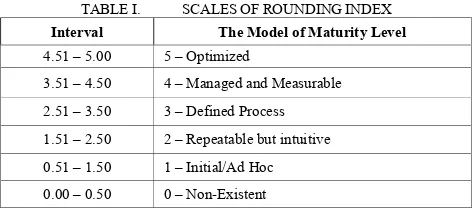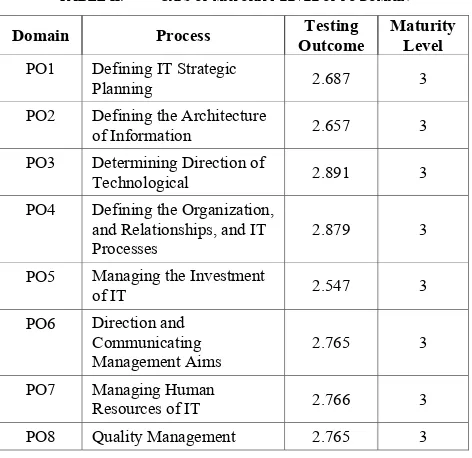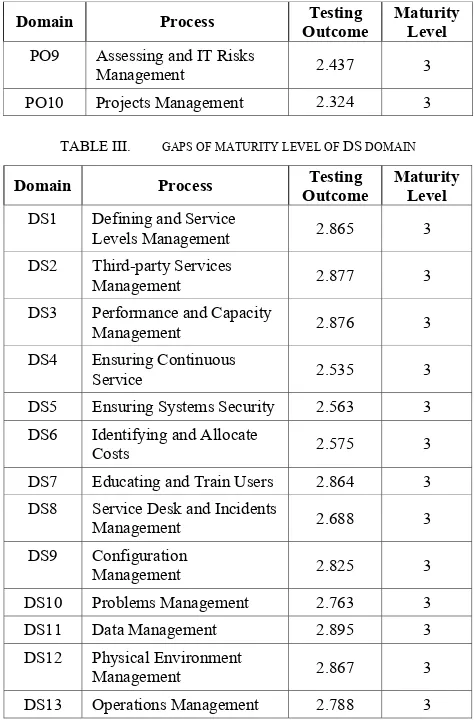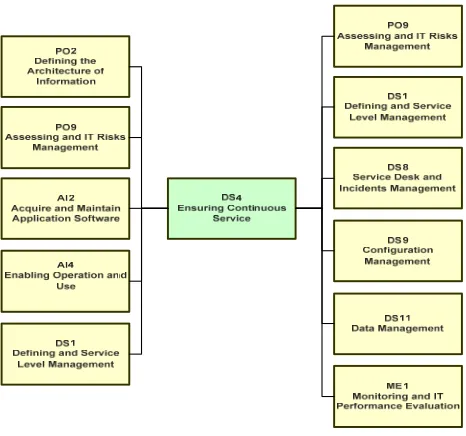Evaluation of Information Technology Governance
Implementation in Business Enterprises
Case: Family Business Enterprises Pontianak, West Kalimantan, Indonesia
Sandy Kosasi, Harjanto Prabowo Doctoral of Research in Management
Business Information System, Bina Nusantara University Jakarta, Indonesia
[email protected], [email protected]
Abstract— Evaluation of IT (Information Technology)
governance implementation aims to both ascertain that business goals are achievable and prevent the risks of business process failures by referring to appropriate elements of data management mechanism of family business enterprises. This research was conducted to cognize the gap value of implementation of current and upcoming IT governance and to provide model recommendations of of IT governance concerning objectives and performances of enterprises with association to PO (Plan and Organize), DS (Deliver and Support), and other IT processes using COBIT 4.1. PO domain shows the average value 2.672 and the least value of PO10 is 2.324. Meanwhile, the average value of DS domain is 2.768 and the least value of DS4 is 2.535. This evaluation recommends that an interrelated model of PO10, DS4, and other IT processes truly exists. This idea emphasizes the approach of IT management through the participation of the management and the stakeholders, progress monitoring, and IT risks. The other recommendations are on the redefinition and the determination of responsibilities to ascertain sustainability of service systems and supports of information. Lastly, specific documentation should be possessed to encourage all system needs and activities to serve information needs.
Keywords—Evaluation, Implementation, IT Governance, Plan and Organize, Deliver and Support, COBIT 4.1. Framework
I. INTRODUCTION
Possessing correct, accurate, and relevant IT governanance can improve expectation values [1]. IT governance becomes an essential part in encouraging the success of enterprise governance. IT governance has crucial contributions performing as true solutions in handling the increases of changes and complexities of IT and business needs [2]. The existence of IT governance can increase investments by 40% and ROI by 40%. These increasing percentages can contribute to 20% of profits [3]. Another fact is that in comparison to the other enterprises, those equipped with fine and standardized IT governance can gain 25% of bigger profits [4]. It is to significantly imply that the management, the stakeholders, and primarily, family business enterprises should implement IT governance.
Managing IT governance of family business and public enterprises is not much different. Family business enterprises possess work units or IT governance departments assigned for the management of the use of IT resources. Furthermore, they have portfolios of applications used to support the whole
operational activities, the management, and the information required by the top management, and capabilites to interactively communicate with consumers to exchange information of products. IT becomes more essential in re-enactment and optimization of business processes. To restate, it is claimed that IT has become an important part and significantly influences planning of business strategies of business enterprises [5]. The cultures of innovation and leadership of IT are primary aspects considered when planning conformity of business strategies and are apt to focus on situations through the placement of social systems and techniques for similar purposes [6].
The easiness of obtaining relevant, punctual, and accurate information is clearly required to make services available to the consumers. To give services with reliable IT performances, guarantee the performance of each business process, and effectively and efficiently reach the goals, there should be accurate IT governance. It is necessary for family business enterprises, especially those located in West Kalimantan, Indonesia to possess IT service systems supported with the whole information.
The majority of family business enterprises in West Kalimantan, Indonesia have had IT departments of IT. The jobs, however, are combined with the others. The work systems generally refer to demands and supplies of business processes. Processes, procedures, and mechanisms of each work unit still refer to hierachical patterns and seniority levels of family stratification. Short-term decisions of IT investments focus on operational funding. Therefore, additional values do not exist. Also, contextual variables often indicate the absence of relationships between IT ratios and performances, and reactive patterns of integration of business functions and IT.
In managing IT, the processes should be efficient and standardized and fulfill business expectations on availability of important information through IT. IT integration ascertains that the business processes are sustainable and, hence, influence the indicator dimensions of enterprise performances. Evaluation of IT governance is importantly applied for the achievement of business objectives and avoidance of business process failures by referring to appropriate elements of data management mechanism and information of family business enterprises.
This paper evaluated the examination of appropriateness, whereby the checking mechanism was more focused on PO and DS domains [7]. These two domains go through the identification of objectives of controls and main subcontrols managing the related IT processes. In conducting maintenance, business processes need to be evaluated and their performance indicator achievement needs to be determined based on the condition of each family business enterprise. The values of indicator achievement of IT governance performances can be cognized by using COBIT 4.1 (Control Objectives for Information and Related Technology) framework [7]. This paper only discussed IT governance. The results of evaluation can become new recommendations in reformulating the implementation of IT governance for the needs of information integration in family business enterprises. Specifically, the main research questions were (a) how is the gap value of implementation of IT governance? and (b) what are the recommendations of the model of IT governance?
It is of great importance for the management and the stakeholders to possess accurate IT governance in optimizing the enterprise resources to keep the competitiveness. IT governance should ensure the goal achievement and the risk avoidance of business process unsuitability through the consideration of all appropriate elements when having the information management [8]. IT governance crucially performs to synchronize the enterprise governance, covers leadership elements, business structures, and processes, and fulfills IT conformity strategies and success of businesses to to get new business opportunities and managing IT risks well [8].
The previous researches empirically show that the existence of IT governance strategically becomes the basic of conformity, reliability, and innovation in building performance values of family business enterprises [9]. Because of less attention on IT management, the increments of IT investments in governmental sectors are not well governed. IT governance needs to be continually improved through IT services [10]. In addition, control processes of IT should be selected and have the abilities of identification and implementation of business strategies and IT [11].
Previous researches relevantly support this research in the scope on IT governance implementation of service availability and information supports. It also includes the discussion of implications for aspects of management and models of processes noting IT governance derived from input and output based on indicators of goals and performances of family business enterprises, the strategies of IT conformity and businesses strategies optimization of IT resources, IT targets, IT risk management, and the IT quality based on the business
needs. This research comprehensively evaluated the implementation of maturity levels and concerned implications of aspects of management and recommendations of the model of IT governance processes derived from input and output of objectives of controls based on indicators of key goals and key performance.
This research aimed to cognize the value of the gap on current and upcoming IT governance. Next, on the basis of the yielded value, the suggestions on the model of IT governance concerning objectives and performances of enterprises with association to PO, DS, and other IT processes were given. To ascertain that accurate planning and organization of IT governance are accurate, the availability of service systems and IT governance supports should be based on the needs.
II. METHODOLOGY
This survey research applied research and development (R&D) method. The sample consisted of 30% of 100 family business enterprises that have implemented IT in Pontianak, West Kalimantan, Indonesia. They were selected through graded sampling technique. Representing each enterprise, 5 respondents were chosen, making a total of 150. The instruments were questionnaires in which items were grouped based on each process divided based on its level. Guttman scales were additionally served. Each maturity level was computed by using COBIT 4.1. framework. Initially, the average values were sought. Finally, the aggregation results of maturity levels were computed by use of Microsoft Excel and shown in a table and the chart of the radar.
Maturity level evaluation of IT processes is different when emphasizing their fulfillment criteria. The way to get the value of the maturity level is by using the pattern: The value of the index = {∑ (answer total x the value of the maturity) ÷ (questions quantity x respondent quantity)}. Table I shows the interval of the rounding indexes of the model of the maturity level [12].
TABLE I. SCALESOFROUNDINGINDEX
Interval The Model of Maturity Level
III. LITERATURE REVIEW
IT governance is important in governance of enterprises including of leadership, structures, and processes applied to give assurance of the sustainability and can make improvement of the aims and the strategies [13]. IT governance correctly states decisions and the framework of the accountability to drive the expected behavior of functioning IT [14]. Also, it contributes to decision making [14]. Its performance aims to meet IT conformity and enterprise objectives, allow enterprises to possess new business chances, obtain good profits with reliable system of management, and implement the management of risk. To reach the success, IT should be monitored by IT departments and managed by the corporate level to make integration of the whole business process units [15].
A. COBIT 4.1 Framework
PO, AI, DS, and ME are four domains from the framework COBIT 4.1 [16]. Regarding the availability of service and IT supports, DS domain is the only focus. The evaluation of the maturity level of DS domain indicates that IT governance is ready to use to reach the conformity of strategies and goals of enterprises. The Applied IT covers business controls and IT. The Framework of COBIT 4.1. provides solutions through the levels of objectives of controls consisting of tasks and activities, process, and domains. The guidelines of COBIT 4.1 consist of objectives of controls guidelines of audit and management. It is emphasized on how business process and controls are oriented by applying a measurement to get a better outcome on the basis of the needs [15-16].
B. PO Domain
PO domain consists of strategies, and indentification of IT mechanism contributing business target achievement [16]. Moreover, strategies should be in good planning and management, communicated, and managed, and IT infrastructure should be functioned [16]. IT processes of PO domain comprises PO1, PO2, PO3, PO4, PO5, PO6, PO7, PO8, PO9, and PO10 [16].
C. DS Domain
In terms of a successful and important factor, DS domain covers IT conformity services and priorities of business, IT costs optimization, users’ abilities to use IT system to productively and safely use secrecy, integrity, and availability of information flows [15]. DS1, DS2, DS3, DS4, DS5, DS6, DS7, DS8, DS9, DS10, DS11, DS12, and DS13 are those included in the IT processes on DS domain [16].
Fig. 1. Graphic of Maturity Level
IV. RESULTS AND DISCUSSION
The evaluation results of PO domain indicate that PO9 and PO10 have the least current maturity level values (respectively 2.437 and 2.324) (see Table II). These two process values are exactly at the second position and at the interval 1.51 – 2.50. Meanwhile, the values of PO1 to PO8 found rank the third position and the interval 2.51 – 3.50. The average value of PO domain is 2.672 and PO3 process has the greatest value (2.891). Furthermore, for DS domain, the least current maturity level value (2.535) (see Table III) is possessed by DS4, whereas the greatest one (2.895) is possessed by DS11. The average value of DS domain is 2.768.
TABLE II. GAPS OF MATURITY LEVEL OF PO DOMAIN
Domain Process Outcome Testing Maturity Level
PO1 Defining IT Strategic
Planning 2.687 3
PO2 Defining the Architecture
of Information 2.657 3
PO3 Determining Direction of
Technological 2.891 3
PO4 Defining the Organization, and Relationships, and IT
Processes 2.879 3
PO5 Managing the Investment
of IT 2.547 3
PO6 Direction and
Communicating
Management Aims 2.765 3
PO7 Managing Human
Resources of IT 2.766 3
Domain Process Outcome Testing Maturity Level PO9 Assessing and IT Risks
Management 2.437 3
PO10 Projects Management 2.324 3
TABLE III. GAPS OF MATURITY LEVEL OF DS DOMAIN
Domain Process Outcome Testing Maturity Level
DS1 Defining and Service
Levels Management 2.865 3
DS2 Third-party Services
Management 2.877 3
DS3 Performance and Capacity
Management 2.876 3
DS4 Ensuring Continuous
Service 2.535 3
DS5 Ensuring Systems Security 2.563 3
DS6 Identifying and Allocate
Costs 2.575 3
DS7 Educating and Train Users 2.864 3
DS8 Service Desk and Incidents
Management 2.688 3
DS9 Configuration
Management 2.825 3
DS10 Problems Management 2.763 3
DS11 Data Management 2.895 3
DS12 Physical Environment
Management 2.867 3
DS13 Operations Management 2.788 3
A. Maturity Gap Analysis
Evaluation of IT governance implementation shows that values of PO and DS domains have not completely been at maturity criteria or the third position. The least values of PO10 and DS4 are respectively 2.324 and 2.535. DS4 value is already at the third position. In comparison to the other values, nonetheless, it is still very small in number. The values found through this evaluation suggest that IT governance of family business enterprises have not fully had accurate structures, mechanism, and processes of business.
The value of PO10 domain shows the gap between the systems and the mechanism of management of IT development. Apart from this, structured ways and methods with obvious and measurable limitation in terms of funding and the management of application portfolios are only based on the needs of each work unit. None of the procedures and mechanism of development integration of work units are found (see Figure 2). Moreover, DS4 shows the existence of the gap where the systems have not completely lasted based on the structures, mechanism, and processes of business, and only depend on planning without being clearly formulated and implemented. This happens due to the fact that the majority of the family business enterprises cannot ascertain their survival.
This condition elucidates that the responsibilities to guarantee the sustainability of services and information supports are not well concerned. In other words, unstandardized conformity, unstructured service sustainability, partial availability, and individual-based reliance are generally found (see Figure 3).
Fig. 2. Model of the Maturity Level of PO Domain
Fig. 3. Model of the Maturity Level of DS Domain
B. Managerial Aspects Implications
It is expected that the family business enterprises possessing IT governance can achieve the third position (defined process). The maturity values of PO1 to PO8 have satisfied the achievement standard as they are at the interval 2.51 – 3.50. PO9 and PO10, however, have a difference between 0.563 and 0.676. PO10 requires special treatment to exceed a maximal value 2.51 (see Table IV). The same thing occurs to DS domain since the least value of DS4 with the difference (0.465) was found (see Table IV). This produced value has exceeded a minimal value (2.51). The evaluation results imply that all processes of DS domain have run well because they are already they already ranks the third (defined process).
TABLE IV. MANAGERIAL ASPECTS IMPLICATIONS
Domain Process Maturity Current Expected Maturity Difference Criteria
PO1 Defining IT Strategic Planning 2.687 3 0.313 Priority
PO2 Defining the Architecture of
Information 2.657 3 0.343 Priority
PO3 Determining Direction of
Technological 2.891 3 0.109 Priority
PO4
Defining the Organization, and Relationships, and IT Processes
2.879 3 0.121 Priority
PO5 Managing the Investment of IT 2.547 3 0.453 Priority
PO6
Direction and Communicating Management Aims
2.765 3 0.235 Priority
PO7 Managing Human Resources of IT 2.766 3 0.234 Priority
PO8 Quality Management 2.765 3 0.235 Priority
PO9 Assessing and IT Risks
Management 2.437 3 0.563 Priority PO10 Projects Management 2.324 3 0.676 Super
Priority
DS1 Defining and Service Levels
Management 2.865 3 0.135 Priority
DS2 Third-party Services
Management 2.877 3 0.123 Priority
DS3 Performance and Capacity
Management 2.876 3 0.124
Priority
DS4 Ensuring Continuous
Service 2.535 3 0.465
Super Priority
DS5 Ensuring Systems Security 2.563 3 0.437 Priority
DS6 Identifying and Allocate Costs 2.575 3 0.425 Priority
DS7 Educating and Train Users 2.864 3 0.136 Priority
DS8 Service Desk and Incidents
Management 2.688 3 0.312 Priority DS9 Configuration Management 2.825 3 0.175 Priority
DS10 Problems Management 2.763 3 0.237 Priority
DS11 Data Management 2.895 3 0.105 Priority
DS12 Physical Environment
Management 2.867 3 0.133 Priority 3 Operations Management 2.788 3 0.212 Priority
The evaluation values from levels of maturity indicate that better the performance measurement results are, the higher process the maturity levels are. It is recommended for the management to make observation and identification of the performace measurement outcomes and the levels of maturity processes with focusing on fulfillment objectives of controls. Defining policies and procedures, changing performance indicator values, adding objectives of controls, and improving standardized and superfine IT processes are obviously necessary.
Besides the improvement of processes, the directors should take a number of corrective actions on the incompatibility of existing business processes for the upcoming conditions. There should also be clear and sustainable involvement of the directors, the users, and the public in IT processes to ensure that actions are on the basis of real happenings. Evaluating and managing IT risks and development of application portfolios, for example, need complete documents and procedural organization.
C. Suggestions of IT Governance on PO10 and DS4
The relationship between indicators of performance of PO domain and other objectives of controls is on project management of IT governance. Input objectives of controls comprise PO1, PO5, PO7, PO8, and AI7, while output objectives of controls encompass ME1, PO9, AI1…AI7, PO8, AI1…AI7, DS6, PO1, and PO5. To typically improve the maturity values of PO10, the management and the stakeholders should have accurate planning and organization, departments’ participation in stating IT requirements, definition of project, evaluation, testing, and training. PO10 domain is governed by the establishment of fixed programs and project management approaches applied when coping with IT projects. This enables the participation of the management and the stakeholders in monitoring the progress and the risks of IT (see Figure 4).
Fig. 4. Interrelationship between PO10 and Other IT Processes
Fig. 5. Interrelationship between DS4 and Other IT Processes
V. CONCLUSION AND FUTURE RESEARCH
The evaluation results of implementation of IT governance of family business enterprises show that the average values of PO and DS domains (respectively 2.672 and 2.768) have exceeded 2.51. Comprehensibly, they rank the third position (defined process). The implementation of IT governance has run well through the supports of the management. In the viewpoint on each process, the value of PO10 is 2.324 (less than 2.51). Meanwhile, despite the fact that the value of DS4 is 2.535 (greater than 2.51), it still needs serious attention. The difference value (0.465) recommends that PO10, DS4, and other IT processes are interrelated. The improvement should
be immediately conducted to reach consistent values. In additon, this attention should be continued to evaluate AI and ME domains to obtain complete results of existence of implementation of IT governance of family business enterprises. This stimulus is crucial to achieve the conformity of strategies of businesses and IT and to encourage information needs to achieve indicators of performances and objectives of enterprises.
REFERENCES
[1] R. S. Debreceny, G.L. Gray, “IT Governance and Process Maturity: A Multinational Field Study”, Journal of Information Systems, Vol.27, No.1, Spring 2013, pp. 157-188.
[2] K. K. Asante, “Information Technology Strategic Alignment: A Correlational Study Between The Impact of IT Governance Structures And IT Strategic Alignment”, A Dissertation Presented in Partial Fulfillment Of the Requirements for the Degree Doctor of Philosophy, Capella University, April 2010, ProQuest LLC.
[3] R. Pereira, M.M. Silva, “A Literature Review: Guidelines And Contingency Factors For IT Governance”, European, Mediterranean & Middle Eastern Conference on Information Systems, 2012, pp. 342-360. [4] P. Weill, J.W. Ross, “IT Governance: How Top Performers Manage IT
Decision Rights for Superior Results”, Boston: Harvard Business School Press, 2004.
[5] B. Bigliardi, L. Cassia, A. De Massis, F. Frattini, “Technology Strategy in Family Business: A New Avenue for Research”, International Journal Entrepreneurship and Innovation Management, Vol. 17, No. 1, January 2013, pp. 1-7.
[6] J. Carvalho, R. Francisco, A. P.Relvas, “Family Functioning and Information and Communication Technologies: How Do They Related? A Literature Review”, Computers in Human Behavior, Vol. 45, April 2015, pp. 99-108.
[7] K. Brand, H. Bonnen, IT Governance Based on CoBiT 4.1–A Management Guide, Amersfoort NL, 2007.
[8] M. Panda, “IT Enabled Business Process Reengineering”. International Journal Of Information Technology & Management Information System (IJITMIS), Vol 4, Issue 3, September-December 2013, pp. 85-95. [9] S. Horan, G. Szundi, C. Edward Van Deman, K.P. Whalen, “Technology
and the Family Office”, The Journal of Wealth Management, Fall 2013, Vol. 16, No. 2, Banking Information Source, pp. 99-111.
[10] W. Ly Teo, A. Manaf, P. Lai Fong Choong, “Perceived Effectiveness of Information Technology Governance Initiatives Among IT Practitioners”, International Journal of Engineering Business Management, Vol 15 Issue 19, 2013, pp. 1-9.
[11] H. Rui, Z. Robert W, P. R. Leon, “Influencing The Effectiveness of IT Governance Practices Through Steering Committees and Communication Policies,” European Journal of Information Systems, Vol 19, 2010, pp. 288-302.
[12] R. A. Khther, M. Othman, “Cobit Framework as A Guideline of Effective IT Governance in Higher Education: A Review”, International Journal of Information Technology Convergence and Services (IJITCS) Vol.3, No.1, February 2013, pp. 21-29.
[13] N. Rezaei, “The Evaluation of Implementing IT Governance Controls”, Journal of Applied Business and Finance Researches, Vol.2, Issue 3, 2013, pp. 82-89.
[14] D. Radovanovic, T. Radojevic, D. Lucic, M. Sarac, “Analysis of Methodology for IT Governance and Information Systems Audit”, 6th International Scientific Conference, ISSN 4441 print/ISSN 2029-428X CD, Vilnius Lithuania, May 13-14, 2010, pp. 943-949.
[15] V. Raodeo, “IT Strategy and Governance: Frameworks and Best Practice”, International Journal of Research in Economics & Social Sciences, Vol 2 Issue 3, March, 2012, ISSN:2249-7382, pp. 49-59. [16] IT Governance Institute, “COBIT 4.1: Framework, Objektif kontrols,



